See also
Aircraft of comparable role, configuration, and era
| HW-4 Flamingo | |
|---|---|
| Role | Sailplane |
| National origin | Brazil |
| Manufacturer | Kurt Hendrich |
| Designer | Hans Widmer |
| First flight | 1946 |
| Number built | 1 |
The HW-4 Flamingo, was a Brazilian single-seat sailplane aircraft designed and manufactured for general flying. [1]
The Flamingo was built in Bauru in 1944, designed by Kurt Henrich and Hand Widmer, it resembled the high-performance German gliders of the time. When designing it, Widmer chose a profile with little penetration, but high elevation index. He made more than 40 drawings, and it was with these that the team started the work. Despite the great performance at low speed, it was not adequate to consider it a racing sailplane. The wings profile were strong cambered. Lighter than contemporary German DFS Weihe, though of similar general dimensions. [2]
It was made largely of domestic wood; the outside was made with plywood and painted linho. [2]
It was based at the Aeroclube de Bauru while it was operational. He has won numerous Brazilian sailing championships, and several categories. It was retired for a structural reform in 2002 and continued flying until 2006. Its prefix was PT-PAY. [1]
Data from Pereira de Andrade 1986, p. 101, Simons 2006, p. 26
General characteristics
Performance
Aircraft of comparable role, configuration, and era

The Schempp-Hirth Nimbus-2 is an Open Class glider built by Schempp-Hirth during the 1970s. The Nimbus-2 first flew in April 1971 and a total of over 240 examples of all subtypes have been built until the beginning of the 1980s. It replaced the Schempp-Hirth Cirrus.
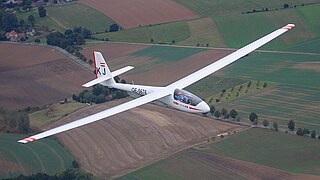
The Schleicher ASW 15 is a single-seat sailplane designed in 1968 by Gerhard Waibel and manufactured by Alexander Schleicher GmbH & Co. The ASW 15 has shoulder-mounted wings and an all-flying tailplane, with its single tow-release placement a compromise between winching and aerotowing. The later ASW 15B had several improvements, including a tow-release placed on the plane of symmetry, an 11 cm taller rudder, a slightly larger main wheel, and the provision of a 90-litre water ballast system.

The Horten H.IV was a German tailless flying wing glider in which the pilot was to lie in a prone position to reduce the frontal area, and hence drag. It was designed by Reimar and Walter Horten in Göttingen. Four were built between 1941 and 1943. They were flown in a number of unofficial competitions in Germany during World War II. After the war the flying examples were transported to the United Kingdom and the United States where several contest successes were achieved.
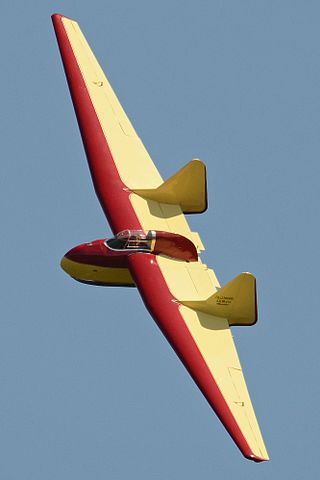
The Fauvel AV.36 was a single-seat tailless glider designed in France in the 1950s by Charles Fauvel. Although the "AV" in AV.36 stands for Aile Volante, it was not a true flying wing: it featured two large fins mounted on stubby tailbooms extending back from the wing's trailing edge, and accommodated the pilot within a stubby fuselage. The aircraft was designed to be quickly disassembled for road transport, with the nose detaching, and the fins able to fold back against the trailing edge of the wing. A refined version with a slightly longer wingspan, the AV.361 was introduced in 1960.
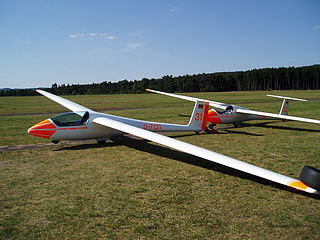
The Schleicher ASK 23 is a single-seat Club Class sailplane that was built by the German manufacturer Alexander Schleicher GmbH & Co.
The ICA IS-32 is an open class high-performance metal two-seat sailplane produced in Romania in the 1970s. A refinement of the IS-28B, it shared most of that aircraft's fuselage, mated to new wings and empennage. This new wing had a span of 20 metres, featuring interconnected ailerons and flaps, Schempp-Hirth-type airbrakes. It had no provision for water ballast. The monowheel undercarriage differed from the IS-28 in being fully retractable.
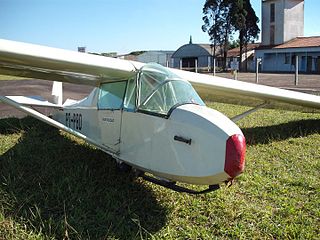
The Neiva B Monitor, also designated B-2, is a Brazilian tandem two-seat glider aircraft designed and manufactured by Indústria Aeronáutica Neiva between 1945 and 1955 for primary training and general flying.

The Slingsby T.49 Capstan is a British two-seat glider of the 1960s built by Slingsby Sailplanes as a replacement for their earlier Type 42 Eagle.
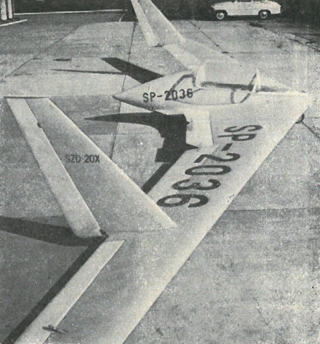
The SZD-20x Wampir II was a single-seat tail-less research glider designed and built in Poland from 1959.
The Airspeed AS.1 Tern was a 1930s British glider aircraft, the first aircraft built by Airspeed Limited at York and one of the earliest British-designed gliders.
The Shenyang X-9 Jian Fan is a Chinese training glider built by the Shenyang Sailplane Factory at Shenyang.

The DFS Weihe is a German single-seat, high-wing, 18 metre wingspan, high-performance glider that was designed by Hans Jacobs in 1937-38.

The Schreder Airmate HP-8 is an American, high-wing single seat glider that was designed by Richard Schreder after the loss of the HP-7 in 1957.
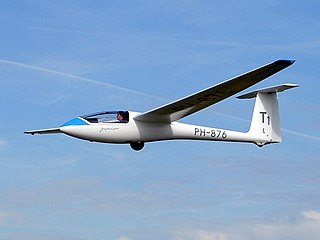
The PZL Bielsko SZD-51 Junior is a Polish single-seat training and club sailplane.
The Reinhard Cumulus is a West German high-wing, strut-braced single-seat, glider that was designed by Gerhard Reinhard for amateur construction.

The ProFe D-8 Moby Dick is a family of Czech pusher configuration, parasol wing, strut-braced, V-tailed, motor gliders that was designed by Oldřich Olšanský, M.Sc, and produced by ProFe as well by several amateur builders according to available plans. The aircraft is named for the great white whale of Herman Melville's novel of the same name and was supplied as a kit for amateur construction.
The Akaflieg Braunschweig SB-8 is an experimental, single-seat, high performance glider built in Germany in the 1960s, constructed largely from glass fibre skin over built up balsa wood structure. Two were built; the second of which was later fitted with a high aspect ratio (30:1) wing, becoming the Akaflieg Braunschweig SB-9 Stratus.
The IPT-5 Jaraguá, was a Brazilian sailplane aircraft designed with two seats in a tandem-seat configuration for general flying.
The IPT-6 Stratus, was a high-performance two-seat, high-wing sailplane.
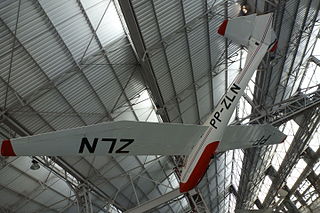
The IPD Periquito, was a single-seat sailplane of high-wing construction designed in 1956 by Guido Pessotti in Brazil.
{{cite book}}: CS1 maint: location missing publisher (link)